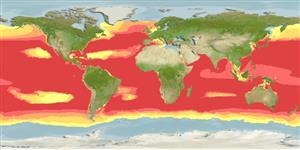Teleostei (teleosts) >
Stomiiformes (Lightfishes and dragonfishes) >
Gonostomatidae (Bristlemouths)
Etymology: Sigmops: Taken from the name of the letter "S, sigma" (Ref. 45335).
More on author: Günther.
Environment: milieu / climate zone / depth range / distribution range
Ecology
Marine; bathypelagic; depth range 25 - 4740 m (Ref. 58018), usually 100 - 1500 m. Deep-water; 65°N -
Worldwide. Mediterranean (Ref. 85016). Eastern Atlantic: scattered records from Iceland (Ref. 4769) south to Cape Verde and Gulf of Guinea; also between 30°S-35°S. Western Atlantic: Gulf of Mexico (Ref. 27768). North Atlantic: 65°-30°N. Indo-Pacific: in tropical and subtropical waters. Eastern Pacific: found in California and Baja California (Ref. 35800), and Chile (Ref. 9068). Indian Ocean, tropical and subtropical waters (Ref. 47377). South China Sea and East China Sea (Ref.74511).
Length at first maturity / Size / Weight / Age
Maturity: Lm ?, range 20 - ? cm
Max length : 27.5 cm TL male/unsexed; (Ref. 4463)
Dorsal spines (total): 0; Dorsal soft rays (total): 11 - 15; Anal spines: 0; Anal soft rays: 27 - 32; Vertebrae: 39 - 41. Black in color, slightly silvery laterally; fins dusky and with small black spots; distal portion of pectorals and pelvic fins colorless (Ref. 3991). Dorsal adipose fin present. Branchiostegal rays: 12-13 (Ref. 35800).
Meso- to bathypelagic (Ref. 58302). Occur between 100-200 m and 500-800 m at night and 25-600 m and 1,250-1,500 m during the day (Ref. 4463). Feed on crustaceans and small fishes (Ref. 4769). Photophores develop in fishes over 6-22 mm SL (Ref. 4769). Protandric hermaphrodite, oviparous with planktonic eggs and larvae (Ref. 35800). Minimum depth from Ref. 4463.
Quéro, J.-C., J.C. Njock and M.M. de la Hoz, 1990. Gonostomatidae. p. 283-292. In J.C. Quero, J.C. Hureau, C. Karrer, A. Post and L. Saldanha (eds.) Check-list of the fishes of the eastern tropical Atlantic (CLOFETA). JNICT, Lisbon; SEI, Paris; and UNESCO, Paris. Vol. 1. (Ref. 4463)
IUCN Red List Status (Ref. 130435: Version 2024-2)
Threat to humans
Harmless
Human uses
Fisheries: of no interest
Tools
Special reports
Download XML
Internet sources
Estimates based on models
Preferred temperature (Ref.
123201): 2.9 - 19.2, mean 6.9 °C (based on 5921 cells).
Phylogenetic diversity index (Ref.
82804): PD
50 = 0.5312 [Uniqueness, from 0.5 = low to 2.0 = high].
Bayesian length-weight: a=0.00288 (0.00164 - 0.00507), b=3.03 (2.87 - 3.19), in cm total length, based on LWR estimates for this species & (Sub)family-body (Ref.
93245).
Trophic level (Ref.
69278): 3.3 ±0.40 se; based on food items.
Resilience (Ref.
120179): Medium, minimum population doubling time 1.4 - 4.4 years (Preliminary K or Fecundity.).
Fishing Vulnerability (Ref.
59153): Low vulnerability (18 of 100).
